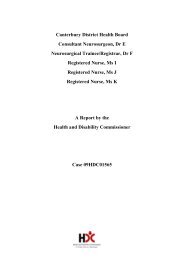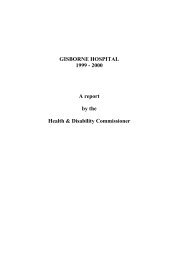Download the pdf version of this decision. - Health and Disability ...
Download the pdf version of this decision. - Health and Disability ...
Download the pdf version of this decision. - Health and Disability ...
Create successful ePaper yourself
Turn your PDF publications into a flip-book with our unique Google optimized e-Paper software.
<strong>Health</strong> <strong>and</strong> <strong>Disability</strong> Commissioner<br />
be within normal limits <strong>and</strong> not indicate a particularly difficult instrumental<br />
delivery.<br />
[Dr B] makes <strong>the</strong> comment that [Baby A] was born with a good heart rate <strong>and</strong><br />
was very pink but not crying, yet paediatricians were crash bleeped. I find <strong>the</strong>se<br />
comments a little inconsistent <strong>and</strong> <strong>this</strong> view is supported by <strong>the</strong> paediatric report<br />
compiled by [a specialist neonatal paediatrician at <strong>the</strong> public hospital]. The<br />
report clearly shows that cord blood gas revealed a pH <strong>of</strong> 6.8875, a base excess<br />
<strong>of</strong> –19.5 <strong>and</strong> lactate <strong>of</strong> 10.94, indicating significant acidosis at birth. The<br />
condition <strong>of</strong> [Baby A] at birth clearly indicated that at one minute <strong>of</strong> age she was<br />
apnoeic, unresponsive, pale <strong>and</strong> atonic, requiring active resuscitation which<br />
included intubation. She clearly was not a pink baby at birth. The CT head scan<br />
performed three days post partum revealed a small smear <strong>of</strong> blood adjacent to <strong>the</strong><br />
falx <strong>and</strong> tentorium with <strong>the</strong> grey-white differentiation being normal. This would<br />
indicate that an anoxic event ante natally, before labour, resulting in cerebral<br />
palsy was unlikely as greater evidence <strong>of</strong> abnormality on CT would have been<br />
expected. The relative lack <strong>of</strong> CT abnormality would suggest that <strong>the</strong> hypoxic<br />
episode leading to <strong>the</strong> development <strong>of</strong> cerebral palsy occurred some time during<br />
<strong>the</strong> labour <strong>and</strong> delivery as it <strong>of</strong>ten takes several days before CT changes develop.<br />
Summary Points <strong>of</strong> Note<br />
1. [Mrs A] clearly had a dysfunctional labour due to occipto-posterior position<br />
creating relative cephalopelvic disproportion.<br />
2. That <strong>the</strong> management <strong>of</strong> <strong>the</strong> first stage by [Dr B] can be considered<br />
appropriate providing <strong>the</strong> option for Caesarean section was repeatedly<br />
discussed <strong>and</strong> that [Mr <strong>and</strong> Mrs A] preferred <strong>the</strong> option <strong>of</strong> continuing with a<br />
trial <strong>of</strong> labour.<br />
3. It is not possible from <strong>the</strong> notes to determine whe<strong>the</strong>r <strong>the</strong> labour plan made<br />
prior to 10.2.2001 in conjunction with [Dr C] to limit <strong>the</strong> first stage to ten<br />
hours was primarily based on <strong>the</strong> clinical wishes/recommendation <strong>of</strong> [Dr C] as<br />
opposed to <strong>the</strong> wishes <strong>of</strong> [Mr <strong>and</strong> Mrs A].<br />
4. A clear CTG abnormality is present from 1600 hours, deteriorating in<br />
character up until <strong>the</strong> trace was discontinued at 1728 hours. I believe that <strong>this</strong><br />
abnormality was overlooked.<br />
5. Given <strong>the</strong> CTG abnormality it seems that <strong>the</strong>re was an inappropriate delay to<br />
effect delivery until 1825 given that <strong>the</strong>re was no reassuring fetal blood<br />
sample taken to contradict <strong>the</strong> CTG suggestion <strong>of</strong> developing fetal hypoxia.<br />
6. The condition <strong>of</strong> [Baby A] at birth <strong>and</strong> <strong>the</strong> relatively normal CT scan suggests<br />
intrapartum hypoxia was <strong>the</strong> cause <strong>of</strong> cerebral palsy. Acute episodes <strong>of</strong><br />
cerebral hypoxia are well tolerated by newborn babies, however prolonged<br />
hypoxia (which can <strong>of</strong>ten be determined by <strong>the</strong> cord blood sample) can cause<br />
cerebral damage.<br />
12 19 September 2006<br />
Names have been removed to protect privacy. Identifying letters are assigned in alphabetical order<br />
<strong>and</strong> bear no relationship to <strong>the</strong> person’s actual name
















